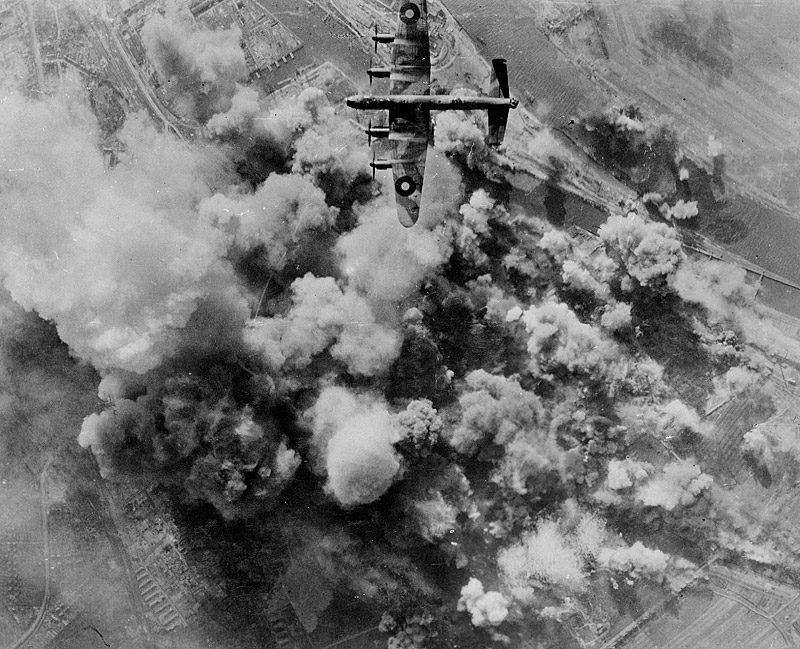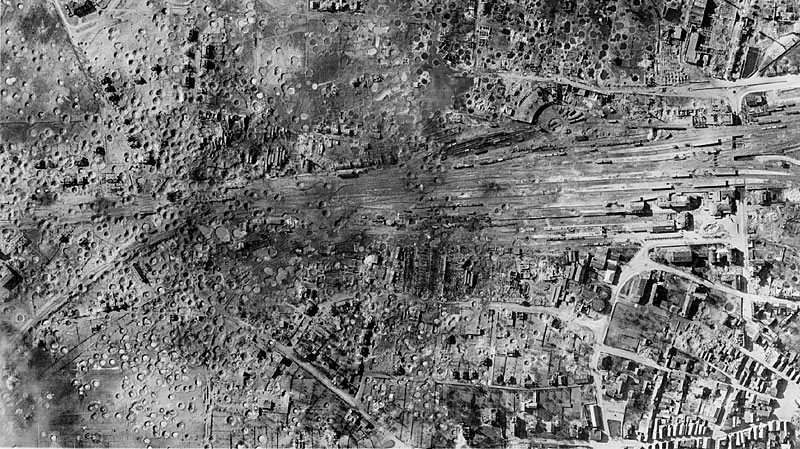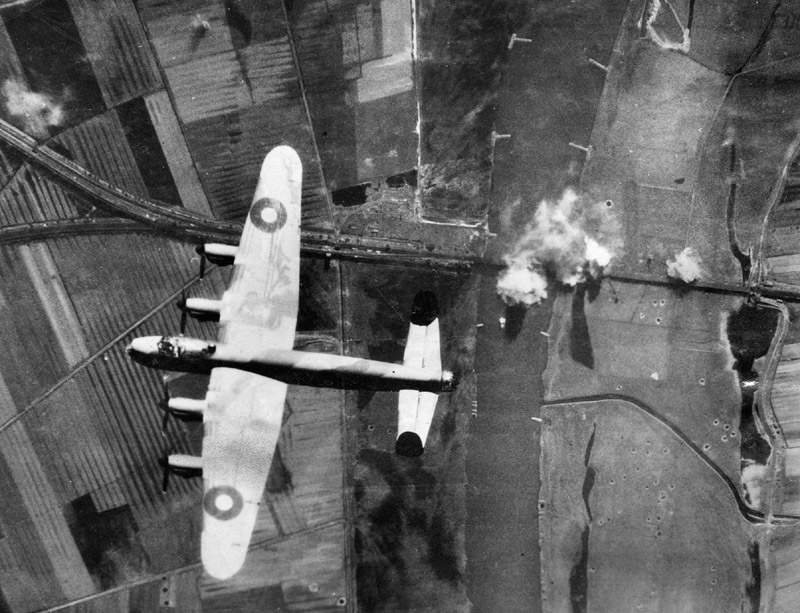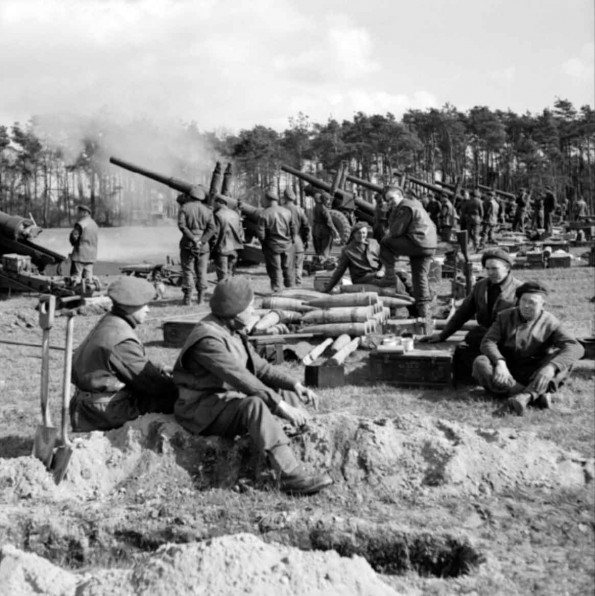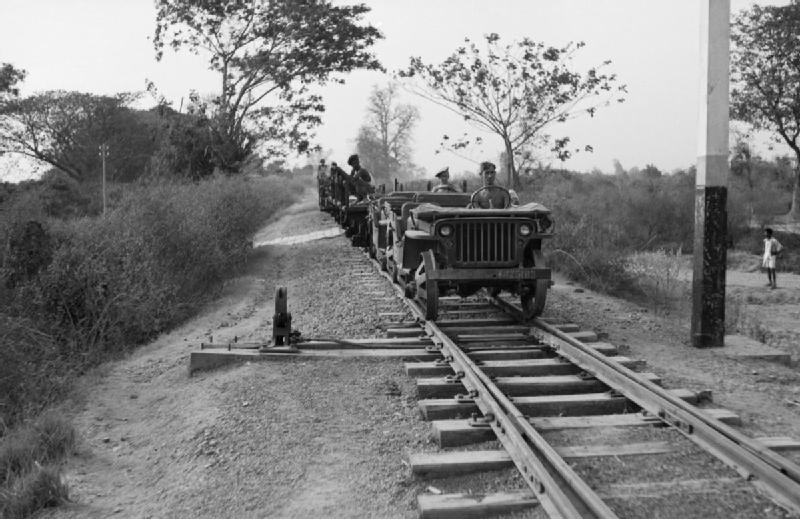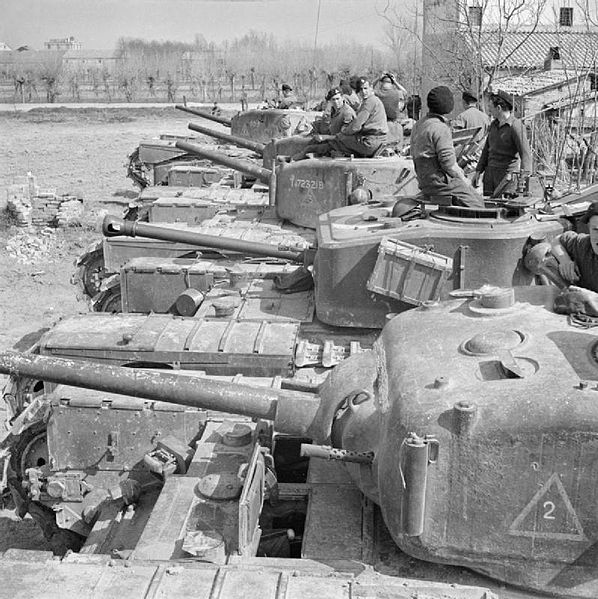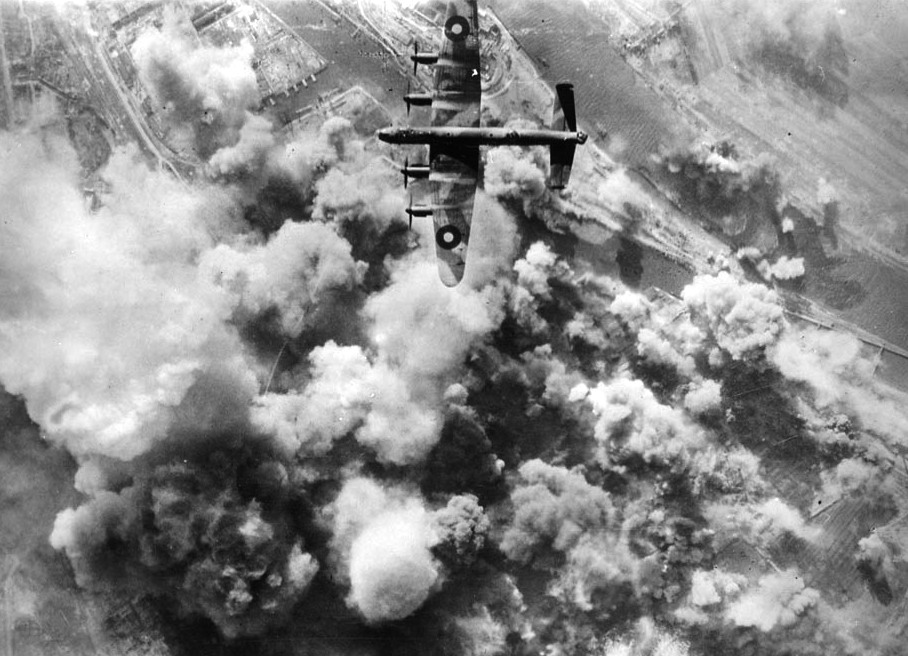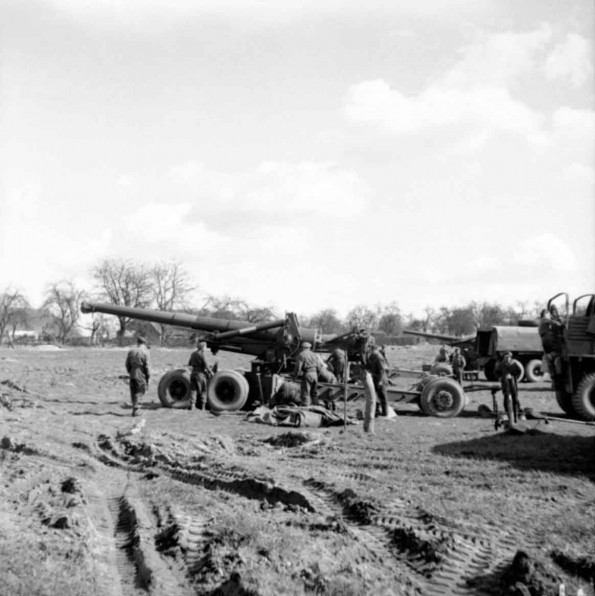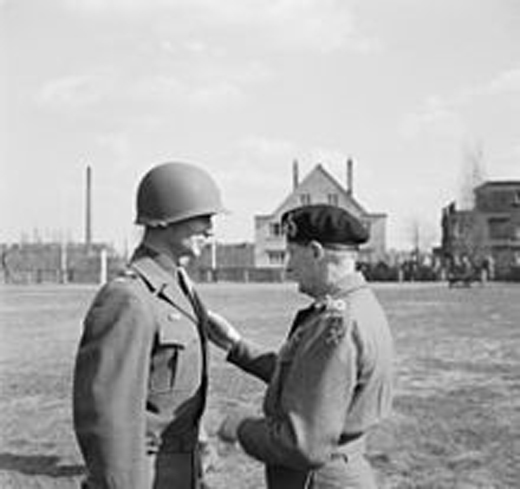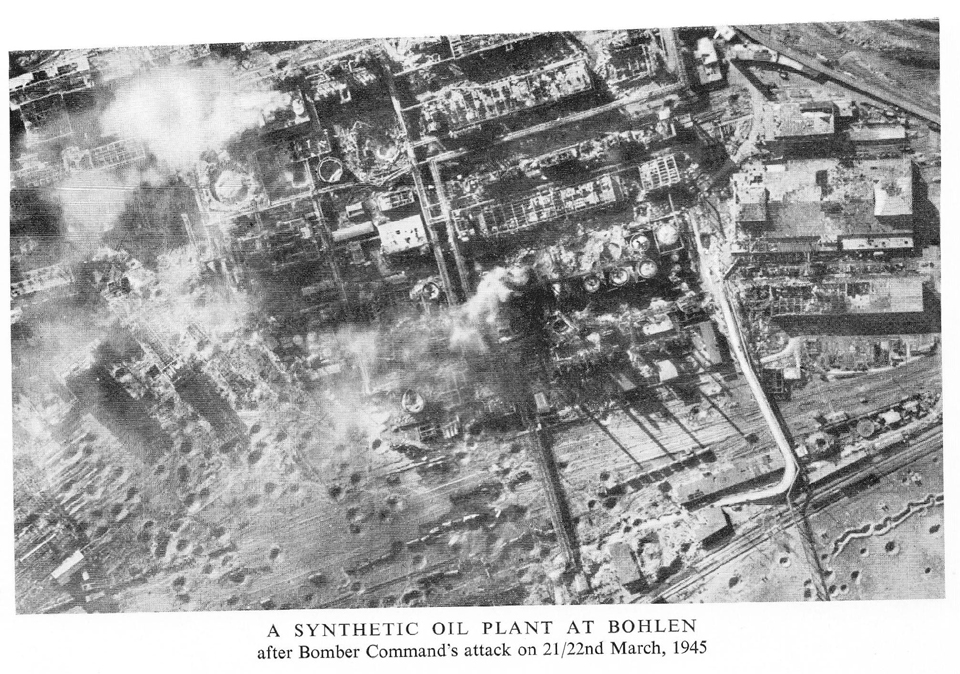Air Operations, CBI
BURMA- 13 10th Air Force B-25s and 18 P-47s attack troops and motor vehicles directly behind the Japanese Army battle lines.
- 34 459th Fighter Squadron P-38s sweep roads south of the battle areas.
- 34 P-47s support Chinese Army ground forces in the Hsipaw area.
- 6 308th Heavy Bomb Group B-24s attack shipping in the South China Sea.
- 37 V Bomber Command B-24s escorted by V Fighter Command P-38s attack the Samah airfield at Hainan.
- 38th Medium Bomb Group B-25s attack shipping near Nanao Island.
- 4 51st Fighter Group P-51s attack rail facilities at the Vinh airfield.
- V Bomber Command B-25s attack a convoy composed of 7 merchant ships escorted by 8 to 10 Japanese fighters. While shooting down an estimated 4 fighters, the B-25s sink a tanker, a submarine chaser, and a repair ship.
- 1 B-25 is lost and 5 are damaged.
Air Operations, Europe
Mosquitoes destroy Gestapo Headquarters in Copenhagen. 35 are killed including 9 Danish prisoners. Bombs accidentally dropped on a nearby Catholic grade school kill 86 pupils and 17 teachers. The 8th Air Force attacks Me-262 bases in western Germany.
RAF BOMBER COMMANDDaylight Ops:
- 178 aircraft including 150 Halifaxes, 16 Lancasters and 12 Mosquitos of Nos. 4, 6 and 8 Groups carry out an accurate attack upon the railway yards and the surrounding town area at Rheine.
- 1 Lancaster is lost.
- 160 Lancasters of No. 3 Group attack the railway yards at Münster and a nearby railway viaduct. The only information available from Münster is that 17 people were killed.
- 3 Lancasters are lost.
- 133 Lancasters and 6 Mosquitos of Nos. 1 and 8 Groups attack the Deutsche Vacuum oil refinery at Bremen. This appears to be an accurate raid in clear weather conditions.
- There are no losses.
- 20 Lancasters of No. 617 Squadron attack the Arbergen railway bridge just outside Bremen. 2 piers of the bridge are destroyed.
- 1 Lancaster is lost.
- 151 Lancasters and 8 Mosquitos of No. 5 Group attack Hamburg. The target for this raid is the Deutsche Erdölwerke refinery. The attack is accurate with 20 storage tanks being destroyed and putting the plant out of action until the end of the war.
- 4 Lancasters are lost.
- 131 Lancasters and 12 Mosquitos of Nos. 1 and 8 Groups carry out an accurate attack on the benzol plant at Bochum.
- 1 Lancaster is lost.
- 142 Mosquitos are sent in 2 attacks to Berlin, with some aircraft making 2 trips, and 3 Mosquitos to Bremen, 7 Mosquitos of No. 5 Group lay mines in Jade Bay and the Weser River, and there are 56 Mosquito patrols and 26 RCM sorties.
- 1 Mosquito is lost on the Berlin raid and 1 RCM Fortress is lost.
GERMANY:
- 364 1st Air Division B-17s, 496 2nd Air Division B-24s, and 351 3rd Air Division B-17s attack 11 Luftwaffe jet-fighter bases.
- 107 3rd Air Division B-17s attack an armored-vehicle factory at Plauen.
- 35 3rd Air Division B-17s attack various targets of opportunity.
- 7 B-17s and 9 of 720 VIII Fighter Command escorts are lost.
GERMANY:
- The 9th Air Division mounts 582 effective sorties against a marshalling yard and six comminications centers east of the Rhine River.
- 8th and 9th Air Force fighter pilots down 18 Luftwaffe aircraft over Germany between 0105 and 1500 hours.
ITALY:
- 12th Air Force B-25s attack two marshalling yards, a rail fill, bridge approaches, and two bridges.
- XXII TAC P-47s attack rail targets and dumps in the Po River valley and near the battle areas.
- During the night, XXII TAC A-20s and A-26s attack crossing points in the Po River valley.
AUSTRIA:
- 15th Air Force heavy bombers attack five marshalling yards at four locations, and a goods depot and three oil refineries in and around Vienna.
- 15th Air Force B-24s effectively destroy the jet-aircraft factory and airdrome at Neuberg.
- 15th Air Force heavy bombers attack a marshalling yard.
Air Operations, Pacific
- Japanese piloted bombs make their first known appearance of the war while futilely attempting to attack the US naval fast carrier task force whose planes were striking targets on Honshu and Kyushu.
- Japanese air attacks around Iwo Jima result in the sinking of the US carrier Bismarck Sea. Bombing and kamikaze raids start fires on the ship that rage out of control and force the crew to abandon the carrier.
Air Operations, Philippines
- V Bomber Command B-25s and A-20s, and V Fighter Command fighter-bombers attack targets throughout Luzon.
- XIII Bomber Command B-24s attack Cebu City.
- V Bomber Command A-20s attack other targets on Cebu.
Air Operations, Western Pacific
Japanese fighters and bombers mount numerous small attacks against Task Force 58 in the area between the Ryukyu and Bonin islands. US Navy carrier-based F6Fs and F4Us down 54 Japanese aircraft at sea between 0336 and 1500 hours, and US Marine Corps carrier-based F4Us down a P1Y 'Galaxy' bomber and a J1N 'Irving' fighter at sea between 1030 and 1045, and 2 J2M 'Jack' fighters at sea at 1420 hours.
[Burma
Japanese resistance ceases in Mandalay. The British 2nd Div advances along the Ava-Mandalay road, and the 20th Indian Div puts pressure on Wundwin. The British 36th Div advancing down from northern Burma with the Chinese New 6th Army reaches Mandalay, and falls back under the British 14th Army jurisdiction.
[China
The Japanese begin to advance against the air base at Laohokow (Guanghua) in the province of Hupeh, northwest of Wuhan.
[Eastern Front
German Army Group E holds the attacks by Yugoslavs and Bulgarians against the Valpovo bridgehead across the Drava. The 3rd Ukraine Front takes the industrial district of Tatabanya, in Hungary, and occupies part of Székesfehérvár. The 1st Ukraine Front attacks in Silesia in the Ratibor-Grottkau (Raciborz-Grodkow) area and savage fighting still rages north and south of Breslau. The 2nd Belorussian Front maintains pressure on the Gdynia-Danzig sector.
GERMANYThe remnants of the German 3rd Panzer Army isolated on the east bank of the Oder River are liquidated near Altdamm: 40,000 killed and 12,000 captured.
HUNGARYAs Soviet forces advance, the German 6th Army is fighting to prevent the encirclement of the 6th SS Panzer Army around Lake Balaton.[MORE]
[Japan
The carrier task force continues their replenishing task to prepare for operations around Okinawa, but the Japanese attacks continue.
[Pacific
- The Japanese submarine chaser No. 33 and cable layer Tateishi are both sunk by US Army aircraft in the South China Sea.
- In an attack on a Japanese convoy off the coast of French Indochina, US submarine Baya (SS-318) sinks the auxiliary netlayer Kainan Maru (524t) off Cam Ranh Bay.
Philippines
On Luzon troops of the 33rd Div, US I Corps, join up with the Filipino guerrillas organized by American armed forces in the north of the island at San Fernando, which is occupied without opposition. The Americans now control all the west coast of Luzon. The 161st Inf, 25th Div, attacks the Japanese positions west of Kapintalan, but powerful and accurate Japanese fire holds up the advance unitl April 8. The 27th Inf, 25th Div, repels vigorous counterattacks by the enemy in the are of Mount Myoko.
In the XI Corps sector, units of the American 6th Div advance about 650 yeards, cutting the track leading from Antipolo northward by way of Guagua. Units of the 43rd Div occupy Mount Caymayuman, Mount Yabang and other heights; other units reach the top of Mount Tanauan. In the US XIV Corps sector, the 158th Inf advances rapidly east of Cuenca as far as the foothills of Mount Macolod.
[Western Front
In the US 1st Army sector, the 78th and 1st Divs, VII Corps, reach the Sieg River. Units of the XII Corps reach Bingen and extend their control along the Rhine as far as Frei Weinheim. The 90th Div is approaching Mainz and liberates much of the territory west of the Rhine. Units of the 4th Arm Div advance northward along the west bank of the Rhine to liberate the region between Worms and Oppenheim. Worms itself is occupied, while south of the city and as far as Mannheim the west bank of the Rhine is occupied by units of the XX Corps. Units of the 12th Arm Div reach the outskirts of Ludwigshafen. Farther south, the 10th Arm Div captures Neustadt, Darmstadt, Annweiler, Queichhambach and Demsieders.
The US 7th Army continues its offensive toward the Rhine. In the XXI Corps sector, the 63rd Div liberates the region around Neukirchen, while on the right flank of the army the 42nd Div, VI Corps, resumes the offensive toward the West Wall.
[Images from March 21, 1945
|
|
|
|
|
|
|
|
|
|
Loading Main Gun Rounds |
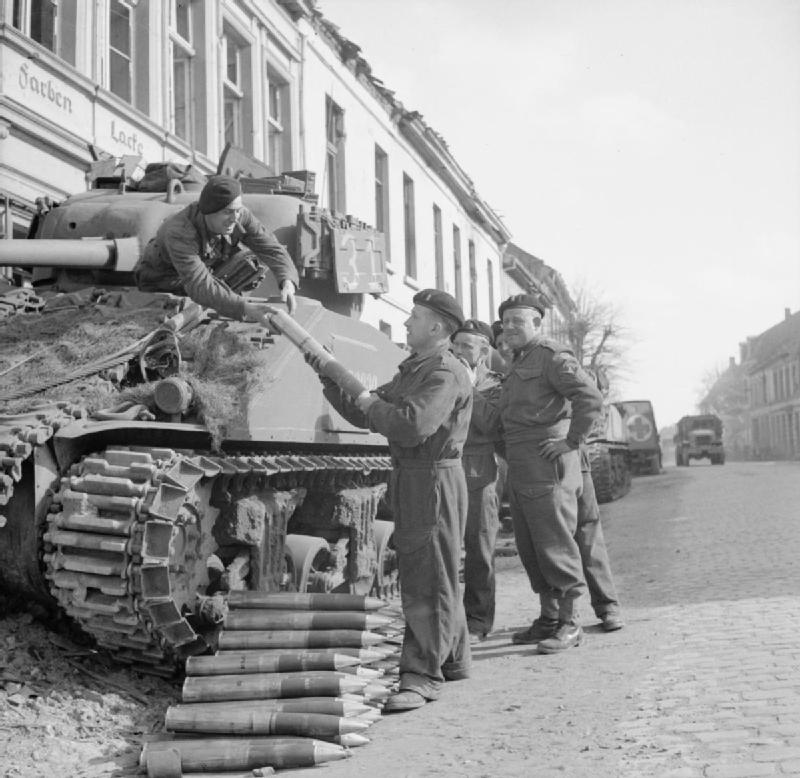 |
